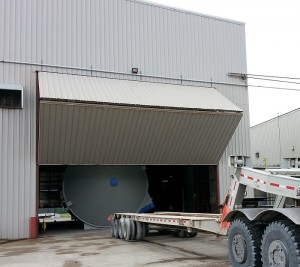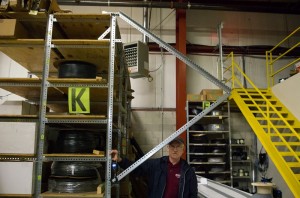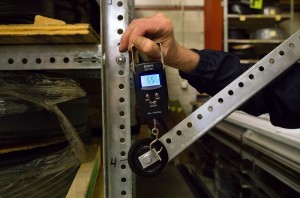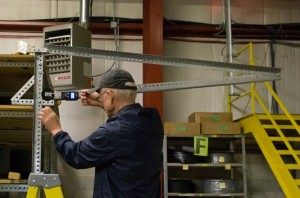Posted May 7th, 2022 at 9:40 am by Liz Dzik
Usually, you can find large bi-fold hangar doors at airports or in specialty production shops. We get requests for torsion spring hardware to counterbalance smaller bi-fold doors from time to time.

On bi-fold doors, the top of the door is hinged and secured to the outside top of the opening. There is a hinge in the middle of the two sections as well. The bottom of the door is pulled up, forcing the hinged middle of the door outward.
There is typically no counterbalance on the larger bi-fold hangar doors. Rather, they are usually winched up with multi-horsepower motors and gearing or chain reduction, which turn multiple straps.
To determine the counterbalance requirements for smaller bi-fold hangar doors, we hinged two pieces of angle weighing five pounds each. A bolt and nut hinged the top, as well as the connecting points for the two angles. A pulley at the bottom of the ten-pound “door” minimized the friction.

We then marked the “opening” every foot, and weighed the “door” at each foot to determine the engineering requirements. Here is what we found at each foot mark, beginning one foot from the bottom.
Weight of the Door
- 6.0 pounds, or 60% at 1 foot
- 6.0 pounds, or 60% at 2 feet
- 5.4 pounds, or 54% at 3 feet
- 5.5 pounds, or 55% at 4 feet
- 5.7 pounds, or 57% at 5 feet
- 5.0 pounds, or 50% at 6 feet
- 4.3 pounds, or 43% at 7 feet
- 5.0 pounds, or 50% at 8 feet

Since the weight varies only slightly throughout its travel, we use vertical lift drums and torsion springs to balance the door.
The goal of springing a door is to minimize the weight variations and the work of opening and closing the door. We split the weight difference of 60% when closed and 50% when opened. This comes to 55% of the door weight.
For a 200-pound door that is eight feet high, we would spring the door for 55% of 200 pounds, or 110 pounds.
Bi-fold doors do not open the full opening height. On this same door, we would open the door to 80% of the height, or about six and one-half feet. Raising the door to 90% of the opening height would bring the door to about seven feet three inches.

Horizontal Force
A serious concern as the door rises is the horizontal force on the rollers pressing against the track or jamb. For example, when the door is at 80% of the opening height, the horizontal force measures 13.4 pounds or 34% more than the door weight. At 90% open, the force pressing against the jamb was 28.1 pounds or 2.81 times the door weight. You need to give special attention to hinge, roller, and track strengths when the door opens to 80% of the opening height or higher.
When properly wound, the 200-pound door will require 5% of 200 pounds or 10 pounds of force at the floor to lift, and pulling the door down from the open position will require about 10 pounds.
Bi-fold hangar doors do not have horizontal tracks. On lighter doors, the vertical tracks turn backward with the curved portion of the track against the jamb. Because of the weight wedged against the tracks when the door is open, we recommend limiting 2″ rollers and tracks to doors weighing less than 150 pounds and 3″ tracks to doors weighing less than 200 pounds. Heavier doors need special heavy-duty wheels riding on steel angle or I-beam jambs.
The only operators that can safely drive these doors are the industrial jackshaft operators. We do not recommend the Liftmaster 8500 for these doors because the cables move too much for the reversing switch arm to work properly.
This entry was filed under How Garage Doors Work, Products. You can follow any responses to this entry through the RSS 2.0 feed.

